trunk AUDI A5 COUPE 2011 Owners Manual
[x] Cancel search | Manufacturer: AUDI, Model Year: 2011, Model line: A5 COUPE, Model: AUDI A5 COUPE 2011Pages: 362, PDF Size: 84.88 MB
Page 4 of 362
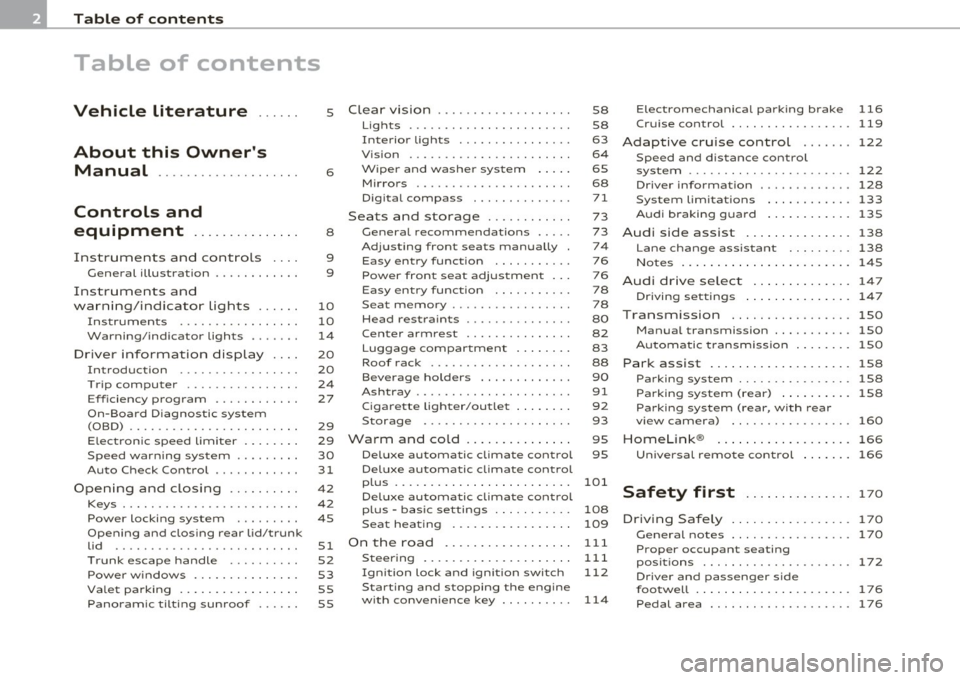
Table of contents
Table of contents
Vehicle literature ..... .
About this Owner's Manual ............. ...... .
Controls and
equipment .............. .
Instruments and controls ... .
General illustration ........... .
Instruments and
warning/indicator Lights ..... .
Instruments ................ .
Warning/indicator ligh ts ..... . .
Driver information display ... .
Introduction .......... ..... . .
Tri p com puter ......... ...... .
Eff iciency program ........... .
On-Board Diagnostic system (OBD) ....................... .
E lectronic speed limiter ....... .
Speed warning system ........ .
Auto Check Control ........... .
Opening and closing ......... .
Keys ........................ .
Powe r locking system ........ .
Opening and closing rear lid/trunk
lid ................... ...... .
T runk escape handle
Power w indows .............. .
Valet parking ................ .
Panoram ic tilting sunroof ..... .
5
6
8
9
9
10
10
1 4
20
20
24
27
29
29
30
31
42
4 2
45
51
52
53
55
55
Clear vision .................. .
Lights ...................... .
Interior lights ............... .
V is ion ...................... .
Wiper and washer system .... .
Mirrors . .............. ...... .
D igital compass ............. .
Seats and storage ........... .
General recommendat ions .... .
Adjust ing front seats manually .
Easy entry function .......... .
Power front seat adjustment .. .
Easy entry funct ion .......... .
S eat memory ............... . .
H ead restra ints ........ ...... .
Center armrest .............. .
Luggage compartment ....... .
Roof rack ................... .
B eve rage hold ers ............ .
Ash tray ..................... .
C igarette lighter/outlet ....... .
Storage ............. ....... .
Warm and cold ........ ...... .
Deluxe automatic climate control
Deluxe automati c climate control
plus ........................ .
Deluxe automatic climate control
plus -basic settings .......... .
Seat heating ........ ........ .
On the road ................. .
Steering .................... .
I gn ition lock and ign ition switch
S tarti ng and stopping the engine
w ith convenience key ......... . 58
58
63
64
65
68
71
73
73
74
7 6
76
78
78
80
82
83
88
90
91
92
93
95
95
101
1 08
109
111
111
112
11 4 Electromechanical park
ing brake 116
Cruise control . . . . . . . . . . . . . . . . . 119
Adaptive cruise control 122
Speed and d istance control
system ................... .... 122
Driver informat ion ............. 128
System limitations ............ 133
Audi braking guard ............ 135
Audi side assist ............. .. 138
Lan e change assis tant ....... .. 138
Notes ................. ....... 145
Audi drive select .............. 14 7
Driving settings ............ ... 147
Transmission ................. 150
Manual transmission . . . . . . . . . . . 150
Automatic transmission .... .... 150
Park assist . . . . . . . . . . . . . . . . . . . . 158
Parking sys tem . . . . . . . . . . . . . . . . 158
Pa rking system (rear) ....... ... 1 58
Park ing sys tem (rear, with rear
view camera) . . . . . . . . . . . . . . . . . 160
Homelink ®
Universa l remote control 1
66
166
Safety first . . . . . . . . . . . . . . . 1 7 0
Driving Safely ................. 170
General notes . . . . . . . . . . . . . . . . . 170
P roper occupant seating
positions . . . . . . . . . . . . . . . . . . . . . 172
Driv er and pass enger side
footwell . . . . . . . . . . . . . . . . . . . . . . 1 76
Pedal area . . . . . . . . . . . . . . . . . . . . 176
Page 11 of 362

Instruments and controls
General illustration
(D Door handle
@ Power locking switch ....... .. .......... ... .. .. . .
@ Adjuster control for outside mirrors . .. .. ......... .
© Memory buttons (driver's seat) .... ... ........... .
® Button for side assist ........... ............... .
© Light switch ........... .. .... .. .. .. .. ...... ... .
0 Instrument lighting . ....... ................... .
@ Control lever for:
- Turn signal and high beam ......... .. .. ....... .
® Multi-function steering wheel with:
- Horn
- Driver's airbag ....... .. .... .... .. .. ...... ... .
- Operating buttons for the audio system
- Rocker switches for tiptronic operation ... .. ..... .
@ SET button .............. ..... ..... ........... .
@ Instrument cluster .... ....... .... .. .. .. .. .. .. . .
@ Reset button for trip odometer .................. .
@ Switches for:
- Windshield wiper/washer ................ .. ... .
- Tr ip computer .. .......... . .. .... .. .. .... ... .
@ Ignition lock ..... .. .................. ... .. ... .
@ Air outlets ........... ... .. ..... ... ........... .
@ Depending on options
- Radio system
- CD changer
@ MMI Display
so
69
78
138 SB
61
62
194
1S6 11
10
13
6S 24
112
107
@ Emergency flasher . . . . . . . . . . . . . . . . . . . . . . . . . . . . . . 62
@ Glove compartment (lockab le) . . . . . . . . . . . . . . . . . . . . 93
Controls and equip
ment Safety first
Instruments and controls
@ Front passenger
's airbag ....... .. .. . .. .. .. .. .. . .
@ Depending on options, sw itches for :
- Electronic Stabili zation Program .. .. .. ......... .
- Rear window sun shade . .... .... .. .. .. .. .. .. . .
@ Deluxe automatic climate control . ... ............ .
@ Ashtray w ith cigarette lighter ........ .... .. .. .. . .
@ Depending on options, selector lever or shift lever for
- Manual transmission ..... ................ .. . .
- Automatic transmission
@ Depending on options :
- MMI contro l conso le or
- Electronic Stabilization Program button
- Power switch for rear window sun shade ...... .. .
@ Start/Stop button ........ .. .. .. ...... ......... .
@ E lectromechanica l parking brake ............... .. .
@ Adjustable steering column ............. .. .... .. .
@ Cruise control ......... .. .... .. .. .. .. ......... .
@ Data Link Connector for On Board Diagnostics (OBD II)
@ Release lever for the engine hood ........ .. .... .. .
@ Switch for unlock ing the trunk lid ........... ..... .
@ Power window switches . .... .. .. .. .... .. .. ..... .
(I) Tips
194
236
65
101
91,92
150
lSO
236
65
114
116 1 11
119 29
274
Sl
S3
Operation of the Multi Media Interface (MMI) is described in a sepa
rate manual. •
Vehicle care Technical data
Page 25 of 362

Open door or trunk Lid warning
The pictogram alerts you when doors or the trunk lid have
been left open.
Fig . 1 3 Disp lay: Open
door- and trunk lid
warning
The Open Door/Trunk Lid warning displays if even one door, the hood
or the trunk lid is open. This symbol also shows
which door or lid has
not been closed~ fig. 13 .
As soon as the door, the hood and the trunk lid are closed properly, the door and trunk lid warning turns off and the selected driver infor
mation system functions are displayed again .•
Con tro ls a nd e quip
m en t Vehicle
OP-eration
Driver information display
Service interval display
The service interval display reminds you when your next
service is due.
Fig. 14 Display:
Service interval display
The schedule for the next oil change or inspection is calculated auto
matically and displayed accord ingly. The display works in two stages :
Service reminder
30 days before the next service is due, a service reminder appears in
the display when you turn on the ignition~ fig. 14.
After about 5 seconds the display switches back to normal. The
distance and time remain ing are updated each time the ign ition is
turned on until the date due for service is reached.
Service due
When the due date for service is reached, the message Service due!
appears in the instrument cluster immediately after you turn on the
ignition. Additionally, a warning tone sounds. After about 5 seconds
the display sw itches back to normal.
Calling up the service schedules
If or when an oil change or inspection is due, can be shown in the
radio or MMI* display by selecting the service interval display in the
car menu. Select
I CAR ]> Service interval display. .,,
Vehicle care Do-it-yourselt service iTechnical data
Page 49 of 362
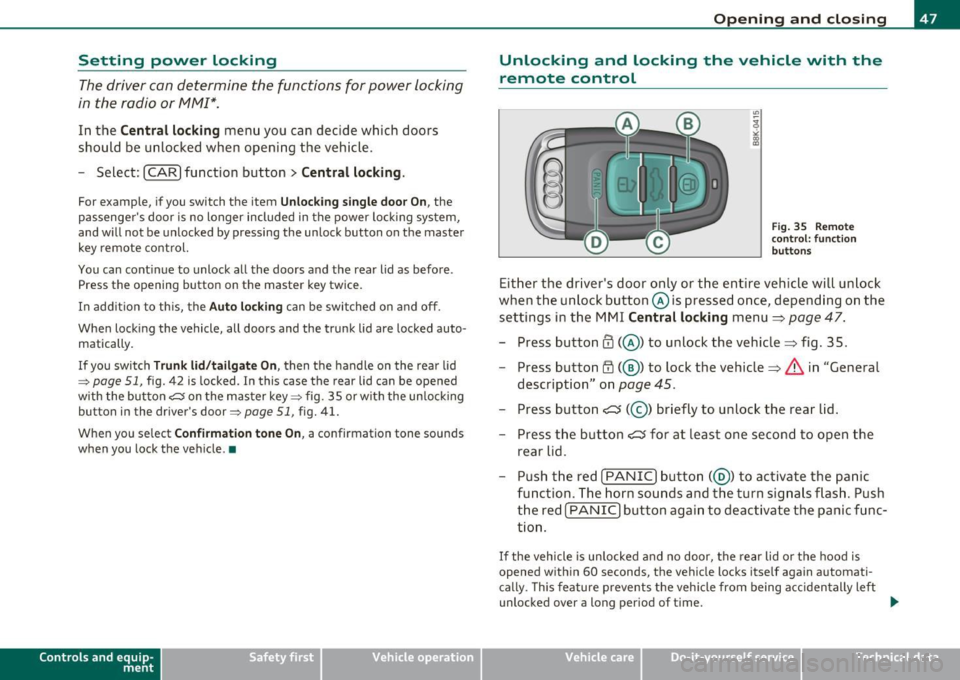
Setting power locking
The driver can determine the functions for power locking
in the radio or fv1fv1I*.
In the Central locking menu you can decide which doors
should be unlocked when opening the vehicle.
- Select: [ CAR] function button> Central locking.
For example, if you switch the item Unlocking single door On, the
passenger's door is no longer included in the power locking system,
and will not be unlocked by pressing the unlock button on the master
key remote control.
You can continue to unlock all the doors and the rear lid as before .
Press the opening button on the master key twice .
In addition to this, the
Auto locking can be switched on and off.
When locking the vehicle, all doors and the trunk lid are locked auto
matically.
If you switch Trunk lid/tailgate On, then the handle on the rear lid
~ page 51, fig. 42 is locked. In this case the rea r lid can be opened
with the button
cs on the master key~ fig. 35 or with the unlocking
button in the driver's door~
page 51, fig. 41.
When you select
Confirmation tone On, a confirmation tone sounds
when you lock the vehicle .•
Con tro ls a nd e quip
m en t Vehicle
OP-eration
Opening and closing
Unlocking and locking the vehicle with the
remote control
Fig. 35 Remote
control: function
buttons
Either the driver's door only or the entire vehicle will unlock
when the unlock button @is pressed once, depending on the
settings in the MMI Central locking menu =>
page 47.
- Press button@(@ ) to unlock the vehicle=> fig. 35 .
- Press button
1'.D (@ ) to lock the vehicle=> & in "General
description" on
page 45.
- Press button C::J (@ ) briefly to unlock the rear lid.
- Press the button
C::J for at least one second to open the
rear lid.
- Push the red !PANIC] button( @) to activate the panic
function. The horn sounds and the turn signals flash. Push
the red [ PANIC] button again to deactivate the panic func
tion.
If the vehicle is unlocked and no door, the rear lid or the hood is
opened within 60 seconds, the vehicle locks itself again automati
cally. This feature prevents the vehicle from being accidentally left
unlocked over a long period of time. .,,_
Vehicle care Do-it-yourselt service Technical data
Page 53 of 362

Emergency locking of the passenger's door
If the power locking system fails (power failure), you will need to lock the passenger door separately.
! a,
Fig. 40 Emergency
locking of the
passenger's door
An emergency locking mechanism is integrated in the edge of
the passenger's door (only visible when the door is open).
- Take the mechanical key out of the master key::::,
page 44.
-Open the door.
- Pull the protective cover out of the hole::::, fig. 40.
- Insert the mechanical key into the inner slot and turn it to
the right as far as it can go .
After you close the door, you will no longer be able to open it from the
outside . The door can be opened from the inside by pulling once on
the door handle .•
Con tro ls a nd e quip
m en t Vehicle
OP-eration
Opening and closing
Opening and closing rear lid/trunk
lid
Opening the rear lid
Fig. 41 Driver's door:
remote rear lid release
Fig. 42 Position of
handle in the rear lid
- Press the middle button ?::Jon the remote control master
key for at least one second, or
- Pull the release button ?::Jin the driver's door::::, fig . 41.
The rear lid unlocks and opens , or
- Press the handle on the rear lid::::, fig. 42. ..,_
Vehicle care Do-it-yourselt service iTechnical data
Page 54 of 362

Opening and closing
Closing the rear lid
- Pull the rear lid dow n at the grip on the i nside a nd allow it
t o drop g ent ly to c lose it~ &.
LJ}. WARNING
• After closing the rear lid, always pull up on it to make sure that
it is p rope rly closed. Otherwi se it could open suddenly when the
vehicle is moving.
• To help prevent poisonous e xhaust ga s from being d rawn into
the vehicle, always keep the rear lid closed while dri ving. N eve r
tran sport objects larger than those which fit completely into the
luggage area, becau se th en the rear l id cannot be fully clo sed .
• Never leave your vehicle unattended e specially with the rear lid
left op en. A child could crawl into th e car through the luggage
compartment and pull the lid shut , becoming trapped and unable
to get out . To reduce the risk of personal injury, never let children
play in or around your vehicle . Always keep the rea r lid a s well as
the vehicle doors closed when not in u se.
• Alway s ensure that no one is within range of the rear lid when
it is moving, in particular close to the hinges -fingers or hands can
be pinched.
(J] Tips
• When the vehicle is locked, the rear lid can be opened separate ly
by p ressing the button
c::5 on th e maste r key. When yo u close the rear
lid again, it locks automatica lly.
• If the rear lid is open o r not p roper ly closed w hen the ignitio n is
turned on, the door and rear lid warning=>
page 23 appears in the
instrument cluste r display .•
Trunk escape handle
In ca se o f an emergency, the lug gage com partme nt lid
can be opened from the inside using the trunk escape
handle.
Fig. 43 T runk esca pe
handle : view from
in side t he close d trunk
To open luggage compartment lid
- Pull t he hand le down towar ds the bumper ~ fig. 4 3.
The trunk escape handle inside the l uggage compartment lid is made
o f fluorescent mater ial to g low in the dar k.
LJ}. WARNING
The trunk escape handle is to be used only in an emergency .
(J] Tips
The emerge ncy re lease lever should never be used as a hand le for
closing the luggage compartment lid.•
Page 89 of 362
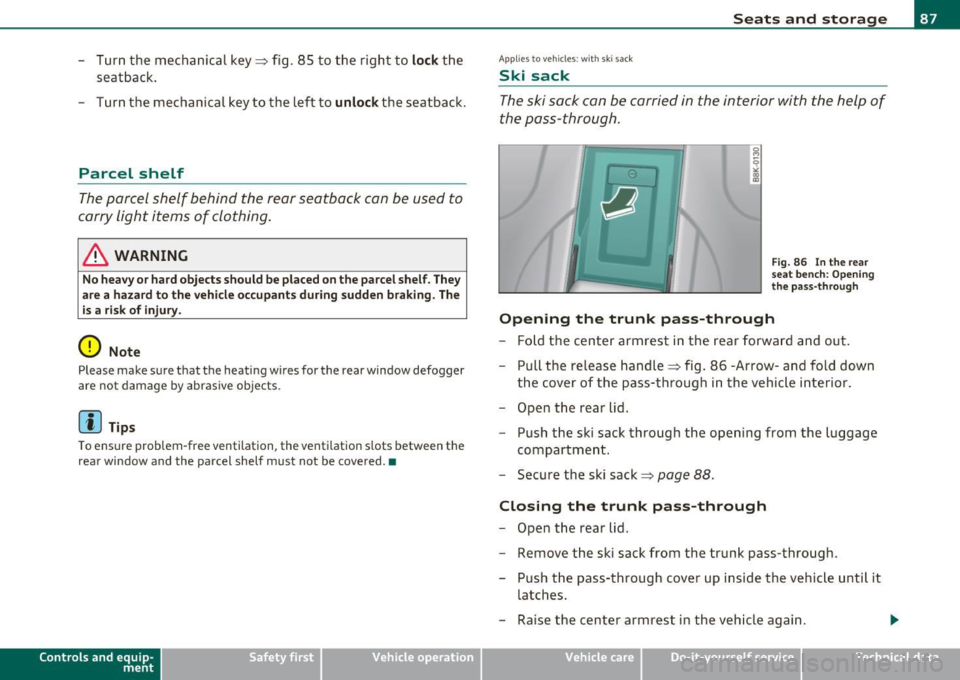
-Turn th e m echanical key=> fig . 85 to the right to lock th e
seatback .
- Tur n the mechanical key to the left to
unlock t h e seatback.
Parcel shelf
The par cel shelf behind the rear seatback can be used to
carry li ght items of clo thing .
& WARNING
No hea vy o r hard objects should be placed on the parcel shelf. They
are a haza rd to the vehicl e occupant s during sudden braking . The
is a risk of injur y.
0 Note
Please make sure that the heating wires for the rear window defogger
are not damage by abrasive objects .
[I] Tips
To ensure problem-free ventilation, the ventilation s lots between the
re ar win dow and the parcel shelf must not be cove red .•
Con tro ls a nd e quip
m en t Vehicle
OP-eration
Seats and storage
Applies to veh icles : w ith ski sack
Ski sack
The ski sack can be carried in th e interior with the help of
the pass-through.
Fig. 86 I n the rea r
s ea t bench : Open ing
t h e pa ss-t hr ough
Opening the trunk pass-through
- Fold the cente r armrest in the rear forward and out.
- Pull the rele ase han dle => fig . 86 -Arrow- an d fold down
th e c ove r of the pass -through i n the vehic le int erior.
- Open the rea r lid.
- Push the ski sack through the opening from the luggage
compartment.
- Secure the s ki sack =>
page 88 .
Closing the trunk pass-through
-Open the rea r lid.
- Remove the ski sack from the trunk pass -through .
- Push t he pass-through cover up inside the vehicle until it
latches .
- Raise t he cen ter armrest in the vehicle again .
Vehicle care Do-it-yourselt service Technical data
Page 162 of 362
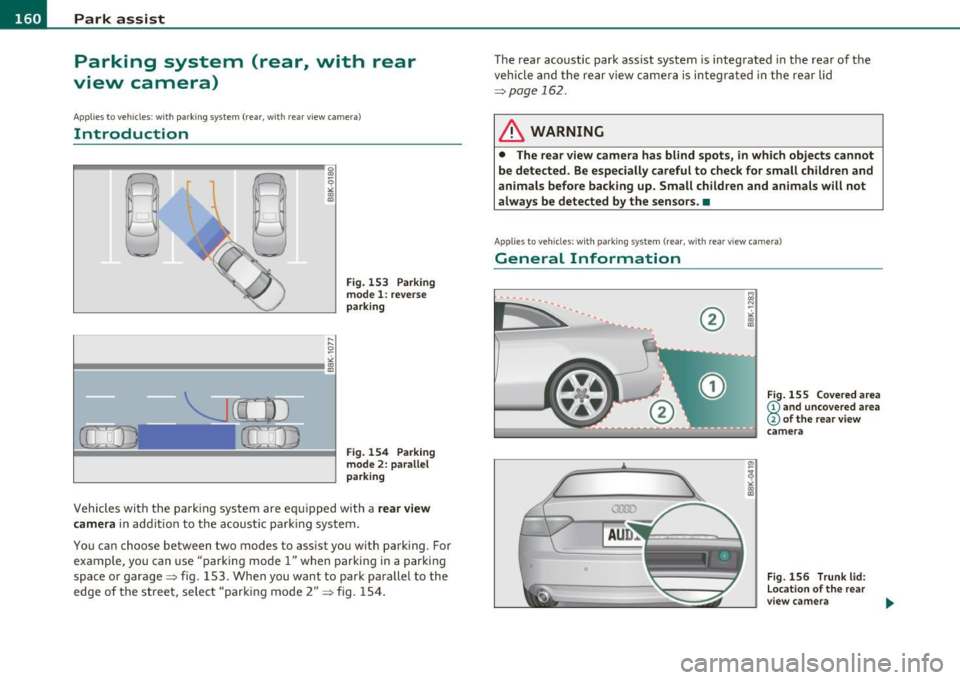
ffl..__P_ a_r_ k_ a_ s_ s _ is_ t ____________________________________________________ _
Parking system (rear, with rear
view camera)
App lies to v ehicles : w ith park ing sys tem (rear, with rear view cam era)
Introduction
0
Fig. 153 Parking
mode 1: reverse
parking
Fig. 154 Parking
mode 2: parallel
parking
Veh icles with the parking system are equipped with a rear view
camera
in addit ion to the acoust ic parking system.
You can choose between two modes to assist you with parking . Fo r
example, you can use "parking mode 1" when parking in a park ing
space or garage~ fig. 153. When you want to park parallel to the
edge of the street, select "parking mode 2" ~fig . 154. The
rear acoustic park assist system is integrated in the rear of the
vehicle and the rear view camera is integrated in the rear lid
~page
162 .
& WARNING
• The rear view camera has blind spots, in which objects cannot
be detected . Be especially careful to check for small children and
animals before backing up. Small children and animals will not
always be detected by the sensors. •
Applies to vehicles: w ith park ing system ( rear, wi th rear view camera)
General Information
®
0
Fig. 155 Covered area
(D and uncovered area
@ of the rear view
camera
Fig . 156 Trunk lid:
Location of the rear
view camera
Page 263 of 362
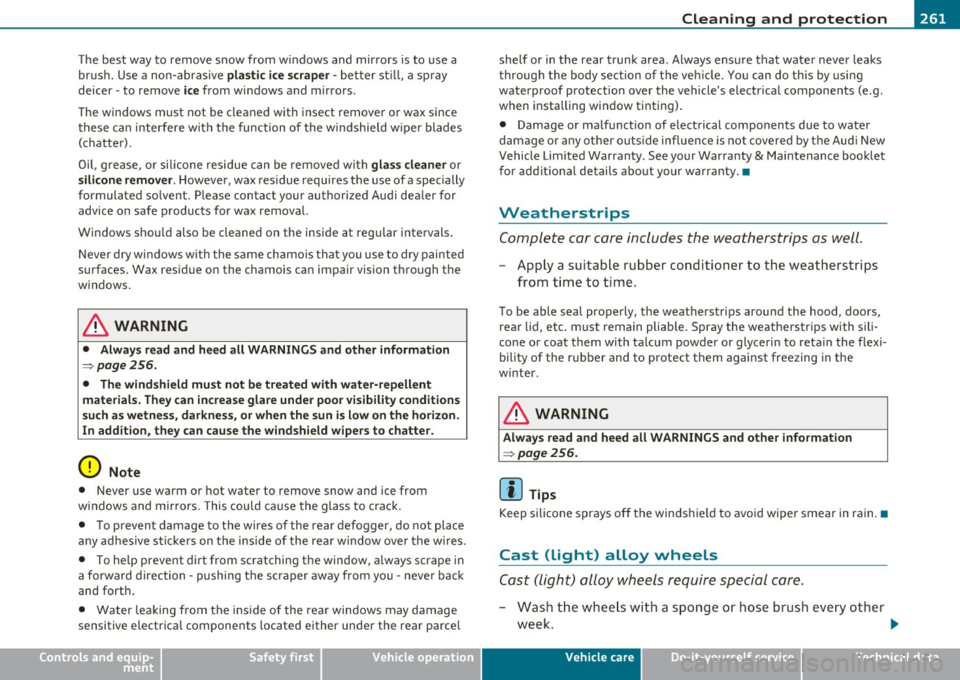
____________________________________________ C_l_e _a_ n_ i n--= g=--- a_n_ d----' p,__ r_o _t_ e_ c_ t_ i _o_ n __ _
The best way to remove snow from windows and mirrors is to use a
brush. Use a non-abrasive
plastic ice scraper -better still, a spray
deicer -to remove
ice from windows and mirrors.
Th e windows must not be cleaned with insect remover or wax since
these can interfere with the function of the windshie ld wipe r blades
(chatter).
Oil , grease, or silicone residue can be removed with
glass cleaner or
silicone remover. However, wax residue requires the use of a specially
formulated solvent . P lease contact your authorized Audi dea le r for
advice on safe products for wax removal.
Windows should also be cleaned on the inside at regular intervals .
Never dry windows w ith the same chamo is that you use to dry painted
surfaces. Wax residue on the chamois can impair vision through the
windows.
& WARNING
• Always read and heed all WARNINGS and other information
=> page 256.
• The windshield must not be treated with water-repellent
materials. They can increase glare under poor visibility conditions
such as wetness, darkness, or when the sun is low on the horizon.
In addition, they can cause the windshield wipers to chatter.
0 Note
• Never use warm or hot water to remove snow and ice from
windows and mir rors . This could cause the glass to crack.
• To prevent damage to the wires of the rear defogger, do not place
any adhesive stickers on the inside of the rear window over the wires.
• T o help prevent dirt from scratching the window, a lways scrape in
a forward direction -pushing the scraper away from you -never back
and forth.
• Water leaking from the inside of the rear windows may damage
sensitive e lectrica l components located either under the rear parce l
Safety first
shelf or in the rear trunk area. Always ensure that water never leaks
t hrough the body section of the vehicle . You can do this by using
waterproof protection over the vehicle's electrical components (e .g.
when installing window tinting).
• Damage or malfunct ion of electrical components due to water
damage or any other outside influence is not covered by the Audi New
Vehicle Limited Warranty. See your Warranty
& Ma intenance booklet
for additional details about your warranty .•
Weatherstrips
Complete car care includes the weatherstrips as well.
-Apply a suitable rubber conditioner to the weatherstrips
from time to t ime.
To be able seal properly, the weatherstrips around the hood, doors,
rear lid, etc. must remain pliable. Spray the weatherstrips with sili
cone or coat them with talcum powder or glycerin to reta in the flexi
bility of the rubber and to protect them against freezing in the
wi nter.
& WARNING
Always read and heed all WARNINGS and other information
=> page 256.
[ i ] Tips
Keep silicone sprays off the windshield to avoid wiper smear in rain .•
Cast (Light) alloy wheels
Cast (light) alloy wheels require special care.
- Wash the wheels with a sponge or hose brush every other
week. _,.
Vehicle care Technical data
Page 274 of 362
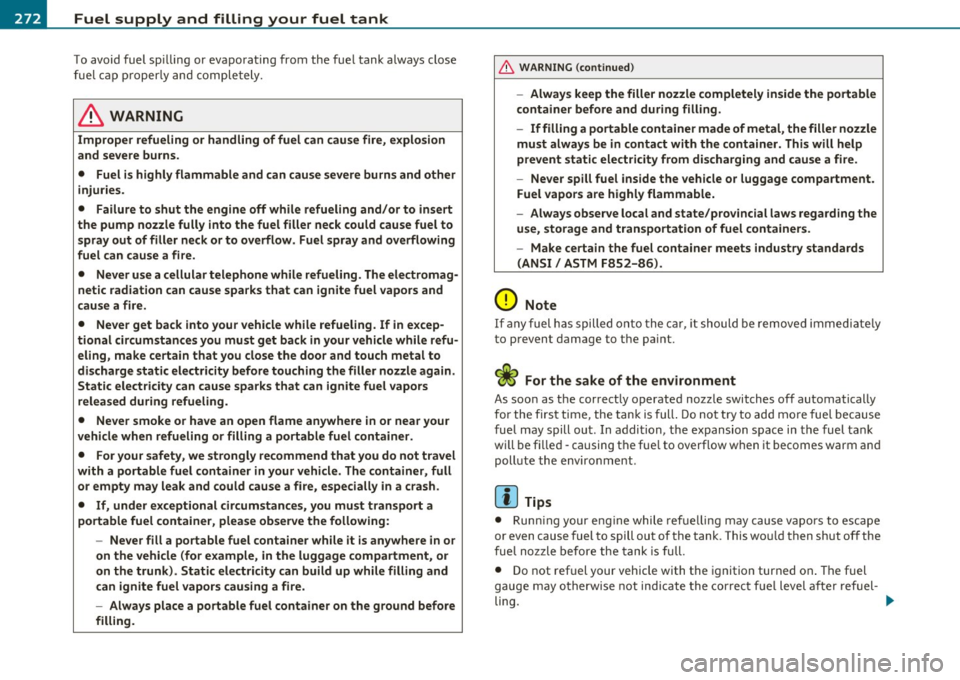
-Fuel supply and filling your fuel tank
P:Vf------=-=----------=-:o..------------
To avoid fu el sp illin g o r evaporat ing from th e fue l tank a lways clos e
fu el cap prop erl y and com plete ly.
& WARNING
Improper refueling or handling of fuel can cause fire, explosion
and severe burns .
• Fuel is highly flammable and can cause severe burns and other
injuries.
• Failure to shut the engine off while refueling and /or to insert
the pump nozzle fully into the fuel filler neck could cause fuel to
spray out of filler neck or to overflow. Fuel spray and overflowing
fuel can cause a fire.
• Never use a cellular telephone while refueling. The electromag
netic radiation can cause sparks that can ignite fuel vapors and
cause a fire.
• Never get back into your vehicle while refueling. If in excep
tional circumstances you must get back in your vehicle while refu eling, make certain that you close the door and touch metal to
discharge static electricity before touching the filler nozzle again.
Static electricity can cause sparks that can ignite fuel vapors
released during refueling.
• Never smoke or have an open flame anywhere in or near your
vehicle when refueling or filling a portable fuel container.
• For your safety, we strongly recommend that you do not travel
with a portable fuel container in your vehicle. The container, full or empty may leak and could cause a fire, especially in a crash .
• If, under exceptional circumstances, you must transport a
portable fuel container , please observe the following:
- Never fill a portable fuel container while it is anywhere in or
on the vehicle (for example, in the luggage compartment, or
on the trunk). Static electricity can build up while filling and
can ignite fuel vapors causing a fire.
- Always place a portable fuel container on the ground before
filling.
& WARNING (co ntinued )
-Always keep the filler nozzle completely inside the portable
container before and during filling .
- If filling a portable container made of metal, the filler nozzle
must always be in contact with the container. This will help
prevent static electricity from discharging and cause a fire.
- Never spill fuel inside the vehicle or luggage compartment .
Fuel vapors are highly flammable.
- Always observe local and state/provincial laws regarding the
use, storage and transportation of fuel containers.
- Make certain the fuel container meets industry standards
(ANSI/ ASTM F852-86).
0 Note
If any fu el ha s sp illed onto t he car , it shoul d be remove d imme diate ly
to p revent damage to the pa int.
fo r the fi rs t time, the tank i s full. D o not try to add mo re fue l because
fu el may spill ou t. In addi tion, t he e xpans ion s pace in the fuel ta nk
w ill b e filled - causing t he fue l to overflow when it becomes warm an d
poll ute the environment .
W Tips
• Runn ing y our e ng in e while ref uellin g m ay caus e vapor s to escape
or
even cause fuel to spill out of the tank . This wo uld then shut of f the
fue l no zzle before the tank is ful l.
• Do not ref uel your vehicle with t he ignition turned on . T h e f uel
g auge may o therwise not indicate the co rrec t fu el level af te r ref uel-
ling . .,_